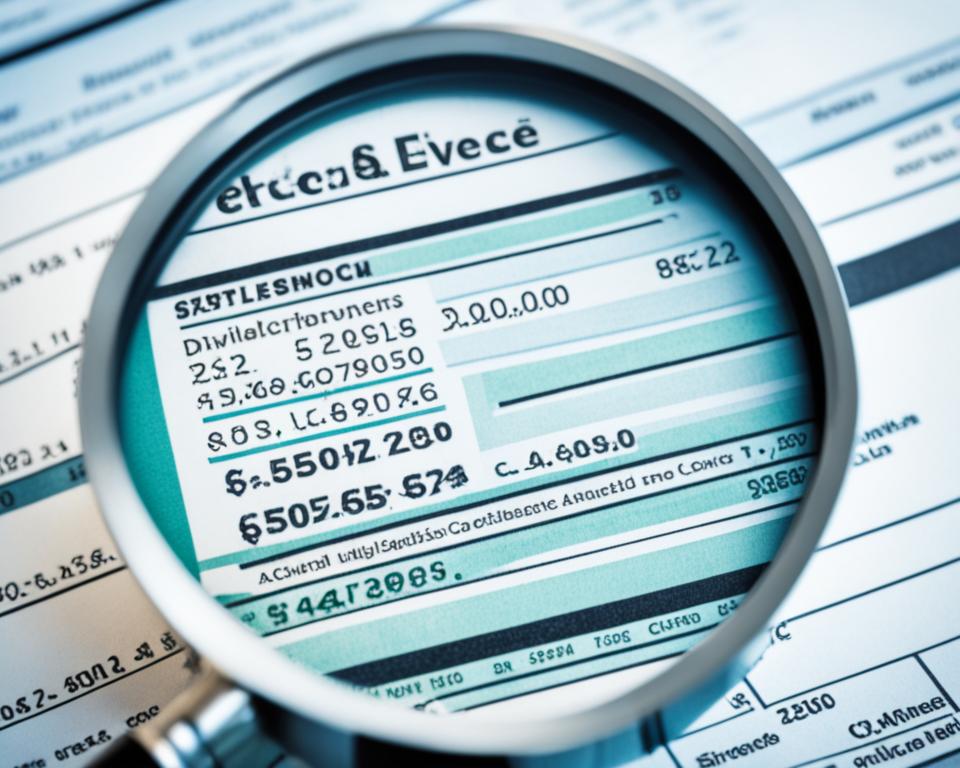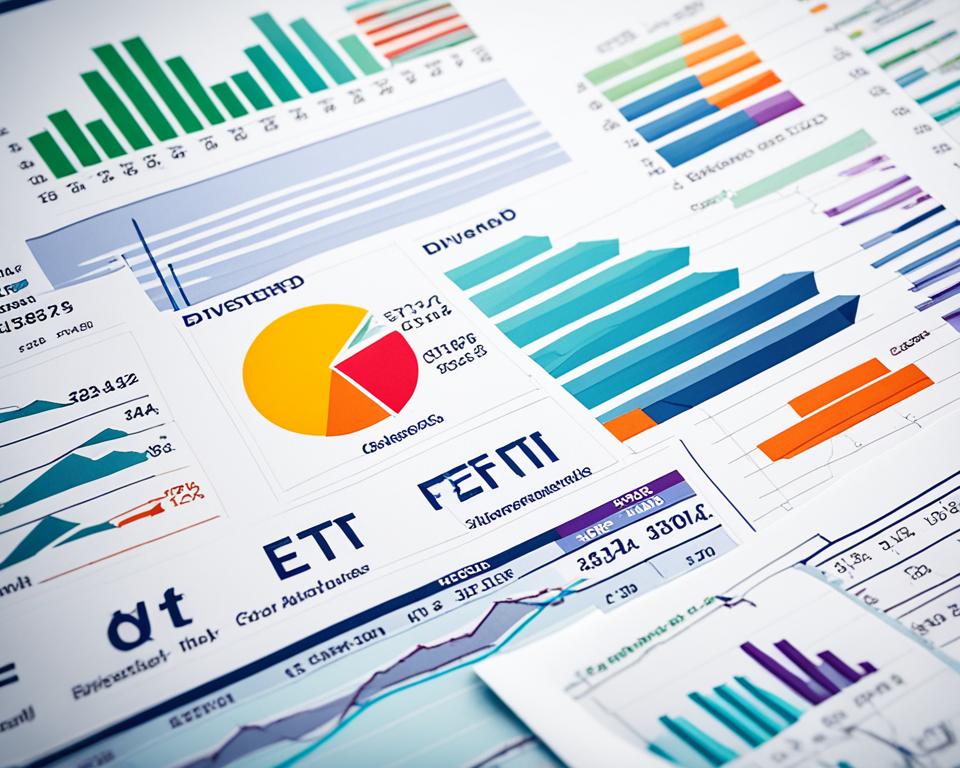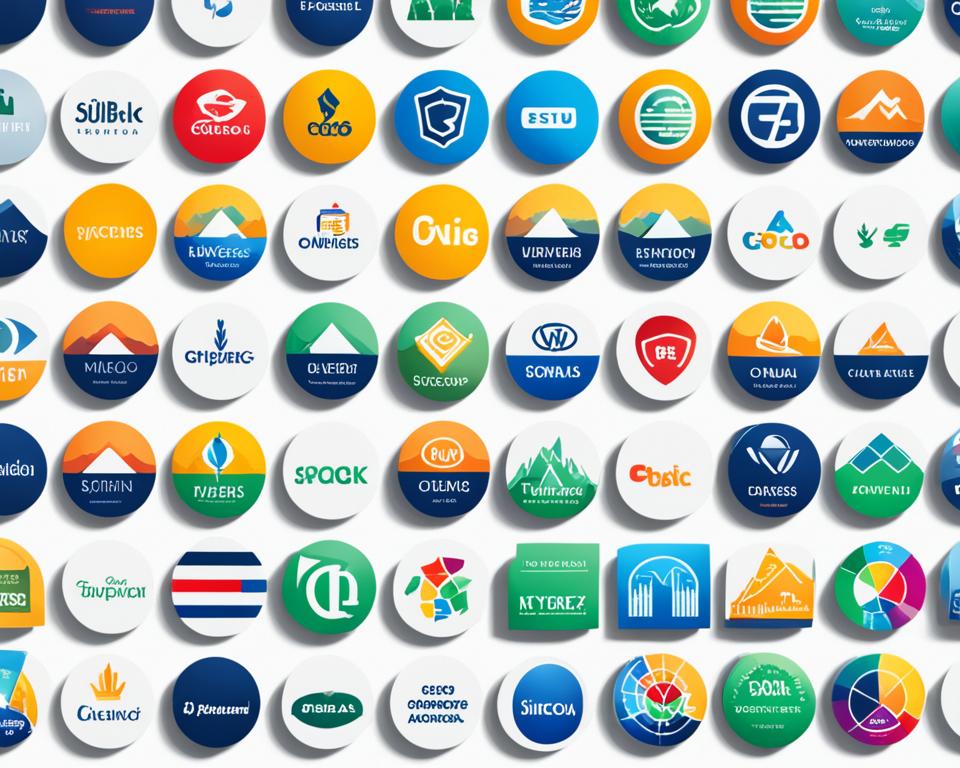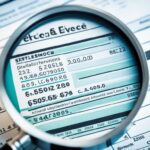When diving into the investment world, you might consider the sustainability of dividend payments a critical factor in building your portfolio. It’s about gauging a company’s capacity to consistently share a slice of its success with you, the shareholders, year after year. This vital aspect of investment income isn’t just about the here and now; it’s a deeper look into the long-term viability of those payments that add to your financial stream.
To conduct a thorough dividend sustainability analysis, you pull out the magnifying glass and scrutinize several indicators of a company’s financial vitality. Key amongst these are cash flow statements and dividend payout ratios from previous fiscal periods. Such scrutiny offers you a forecast of sorts, laying out a pathway of sustainable dividends against the volatile backdrop that is today’s economic climate.
Key Takeaways
- Dividend sustainability analysis is essential for long-term investment income strategies.
- Understanding a company’s ability to pay out sustainable dividends involves looking at cash flow and payout ratios.
- Sustainable dividends are reflective of a company’s ongoing financial health.
- Investigating past financial performance helps predict future dividend consistency.
- Strategic investors weigh both quantitative data and economic forecasts in their analyses.
Understanding Dividend Payments and Investor Expectations
As an investor, your anticipation for dividend yield is akin to awaiting the fruits of a well-tended orchard. The allure isn’t just the yield itself, but also the promise of dividend growth — the incremental increase in the value of dividends over time. In the panorama of investment opportunities, dividends are one of the clearest reflections of a company’s profitability and financial robustness, offering a dual reward: immediate income and potential for capital appreciation.
Cumulative dividends are particularly noteworthy. These dividends are like a reservoir, filled during times of profit and ready for disbursement during the dry spells when companies might otherwise struggle to extend payouts. They are a testament that a company is not just performing well now but is poised for longevity and sustained financial health.
A company’s ability to provide consistent dividends reflects its firm standing in the financial echelons, and it sets precedence for future payouts. This consistency strengthens your confidence in the security of your investments. Your keen eye on a company’s financial health helps ensure that payment backlogs don’t hobble its future cash flows — a critical bastion against financial storms that could erode the value of your investments.
| Dividend Type | Description | Investor Benefit |
|---|---|---|
| Cumulative Dividends | Dividends that accumulate when not paid out and are distributed once the company returns to profitability. | Ensures owed dividends are paid, increasing future income security. |
| Regular Dividends | Dividends paid from a company’s earnings at regular intervals. | Offers a steady income stream and suggests stable financial health. |
| Special Dividends | One-time payments to shareholders when companies have excess profits. | Signals company’s exceptional profitability during a given period. |
When assessing potential investments, savvy investors like you delve beyond the surface, analyzing payout histories, growth trajectories, and the strategic direction of a company. The ability to project the trends in tenure of a dividend policy becomes a tool for safeguarding your financial aspirations. The dividend growth of a firm accentuates not only the potential hike in your income over time but also implicitly speaks to a company’s ambition and strategy for capital retention versus shareholder distribution.
- Review the company’s history of dividend distributions.
- Assess the patterns of dividend growth, noting any upward or stagnant trends.
- Analyze future earnings projections and their implications for sustained dividends.
- Ascertain the growth strategies that may impact future cumulative dividends.
Ultimately, dividends unfold a narrative of a company’s life cycle, corporate philosophy, and respect for shareholder value. They aren’t merely quarterly or annual checks but reflective metrics of a business’s core strength and strategic ingenuity. By investing in a company that demonstrates a pattern of both profitable operations and prudent financial policies, you position yourself to enjoy the yields without the worry of tomorrow’s volatility.
Examining Dividend History and Trends
Peering into the rearview mirror of a company’s financial journey offers valuable insights, and when it comes to dividends, the past can often light the way forward. Delving into dividend history reveals more than mere numbers; it reflects an organization’s enduring commitment to shareholder rewards and its ability to navigate economic landscapes while maintaining financial stability.
Importance of Consistent Dividend Payments
You, as an investor, may find solace in regular returns on your capital. Such consistent dividend payments not only ease immediate financial concerns but also manifest the solidity and reliability of a firm. It’s a financial reassurance, echoing the robustness of a company’s performance through market highs and lows. An uninterrupted flow of dividends is a pledge of dependability, registering the company’s place among the ranks with solid fiscal foundations.
Assessing Dividend Adjustments Over Time
While steady dividends are desirable, a shrewd investor like you assesses how a company adapts its dividends in response to its dynamic operational environment. Dividend adjustments, whether increases, decreases, or suspensions, tell a story—a narrative of prudent management and strategic foresight. Navigating through these historical financial documents lays out an economic tapestry, detailing how a business has throttled its dividends engine through times of abundance and scarcity alike.
| Year | Dividend per Share | Year-over-Year Growth | Notes on Adjustments |
|---|---|---|---|
| 2020 | $1.20 | 5% | Increased amid strong earnings |
| 2021 | $1.25 | 4.2% | Consistent growth, stable market conditions |
| 2022 | $1.10 | -12% | Adjustment due to economic downturn |
By tracing the trajectory of dividends through varied economic climates, a fertile ground forms beneath your investment strategy. It becomes clearer where consistency has been upheld and where nimbleness has been executed through deliberate dividend adjustments. It’s not just a pursuit of yield; it’s an acknowledgement that your financial gains are intertwined with corporate prudence and perseverance.
Dividend Payout Ratio Analysis
When it comes to securing your investment future, understanding the dividend payout ratio is pivotal—especially in times of economic uncertainty. This crucial metric isn’t just any number; it paints a picture of a company’s financial flexibility and indicates how well it can sustain dividends during the unpredictable swings of the economy. Let’s break down why this ratio should be high on your checklist when evaluating any potential investment, particularly for its dividends.
Imagine the dividend payout ratio as a financial compass; it shows the portion of earnings a company chooses to distribute to shareholders. What’s left is then reinvested back into the company to fuel future growth. In an ideal scenario, you’re looking for a ‘Goldilocks’ zone—not too high, not too low. A ratio that’s too high might reveal that a company is giving away more than it can afford, leaving little room for reinvestment or to weather an economic downturn. Conversely, a ratio that’s too low could be a sign of a company hoarding its profits, potentially stunting growth and shareholder returns.
Let’s put things into perspective with a clear example:
| Company | Net Income | Dividends Paid | Dividend Payout Ratio |
|---|---|---|---|
| Company A | $10M | $5M | 50% |
| Company B | $10M | $7M | 70% |
| Company C | $10M | $9M | 90% |
As you can see, Company C pays out the majority of its earnings in dividends, signaling potential risks to its financial stability; whereas Company A maintains a more balanced approach, suggesting a healthier long-term strategy for growth and stability. In your investment journey, your aim is to find a company like Company A—capable of rewarding you now while also setting the stage for future success.
So, during your next dive into a company’s financials, pay close attention to the dividend payout ratio. If it’s too close to 100%, be wary—the intensified economic uncertainty could push such a company into a tight corner. Your financial savvy in spotting a sustainable ratio will be integral in choosing investments that can uphold dividends and adapt to the twists and turns of economic tides.
Significance of Dividend Yield in Investment Decisions
As an investor scouting for lucrative opportunities, the concept of dividend yield is a cornerstone in modern stock valuation. Imagine this metric as your financial beacon, shining light on the prospective returns of one stock relative to its current market price. It’s fundamental, therefore, to grasp how dividend yield calculation operates as an influential factor underpinning your portfolio’s performance and potential.
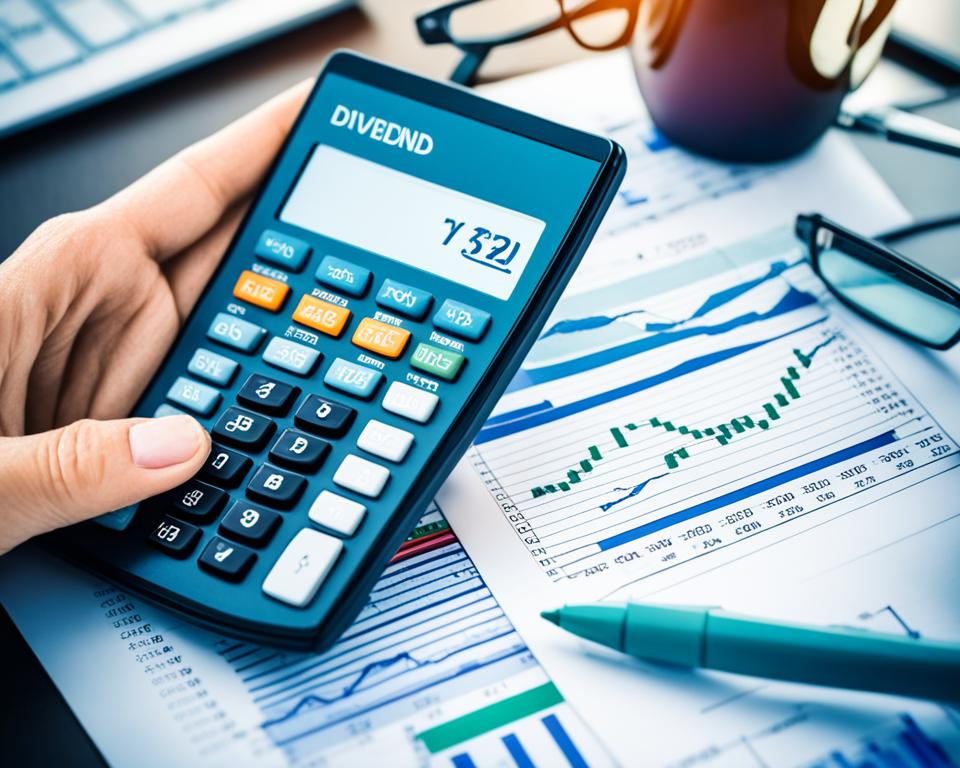
While dividend yield serves as an attractive quantifier for assessing potential returns on investment, it also emboldens you to execute industry comparisons—deciphering how each company stacks up against its sector’s averages and peers. This methodological approach not only informs you of yield prospects but also of a company’s competitive stance within its industry landscape.
Calculating Dividend Yield for Stock Valuation
The dividend yield calculation is more than a mere arithmetic exercise—it embodies an investor’s strategy to measure income generation against market valuation. Taking the annual dividend per share and diving it by the stock’s price, you’re equipped with a percentage that elevates your ability to make considered, calculated decisions. This figure serves as a litmus test for assessing not just the attractiveness of a stock but also its underlying financial health.
Comparing Dividend Yields Across Industries
Your financial acumen extends into the realm of comparative analysis where industry comparison takes center stage. The unique financial climates each sector operates in molds dividend yields. A utility company, for instance, may traditionally offer higher yields due to steadier revenue streams, while a tech startup might present lower yields, focusing on reinvestment for expeditionary growth. Every industry has its norms, and knowing these is crucial as you tailor your portfolio to align with your fiscal goals and risk appetite.
- Retail Sector: Tends to have moderate yields, reflective of both consumer spending trends and economic cycles.
- Energy Sector: Known for higher yields, these stocks can fluctuate with the volatility of energy prices and geopolitical shifts.
- Technology Sector: Often characterized by lower yields due to aggressive growth tactics and reinvestment strategies.
In a landscape brimming with investment choices, your keen ability to calculate and compare dividend yields not only champions your pursuit of returns but anchors your decisions in financial prudence. Engaging with these metrics provides clarity, insight, and a structured pathway to fulfilling your investment objectives.
Assessing Dividend Coverage Ratio
In the quest to fortify your investments against the unforeseen tides of economic downturns, one metric stands out as a beacon of reliability—the dividend coverage ratio. This financial indicator acts as a litmus test to whether a company can continue paying dividends without compromising its stable financial position. It is particularly during these testing economic periods that a robust dividend coverage ratio is most telling of a company’s resilience.
The dividend coverage ratio, in essence, measures the number of times a firm can cover its dividends from its net income. The higher this number, the greater the assurance that your dividend income will remain intact, even as the market ebbs and flows. An impressive coverage ratio is indicative of a surplus that can withstand market fluctuations, safeguarding your dividends.
Think of the dividend coverage ratio as your financial shield; it protects your dividend flow during economic downturns. When you’re pinpointing where to allocate your investment funds, a company sporting a solid coverage ratio can be a signal of a stable financial position and, by extension, a promising prospect for enduring dividend payouts.
While no investment is without risk, analyzing the dividend coverage ratio provides a strategic vantage point. It allows you, the investor, to discern between companies that are merely surviving and those that are thriving with plenty of profit to reward their shareholders. It’s about ensuring that your hard-earned investment returns persist through thick and thin.
For a practical perspective, let’s consider a simplified illustration:
| Company | Net Income | Total Dividends Paid | Dividend Coverage Ratio |
|---|---|---|---|
| Company Alpha | $30M | $10M | 3.0 |
| Company Beta | $20M | $10M | 2.0 |
| Company Gamma | $15M | $10M | 1.5 |
In the table above, companies with higher dividend coverage ratios, like Company Alpha, demonstrate the ability to pay dividends multiple times over their obligation. This strength becomes a comforting promise to you as an investor that the dividends are secure.
As a savvy investor, focusing on dividend coverage ratio assures you’re placing trust in companies likely to sustain dividends, enriching your portfolio and providing a buffer against economic downturns. It’s your move towards strategizing for a stable financial position, ensuring that your investments are as enduring as they are profitable.
Diligence in Cash Flow Assessment
As you hone your investing acumen, it becomes paramount to conduct a meticulous cash flow assessment for any company you’re eyeing. The insights drawn from this exercise are nothing short of revelatory—they peel back the outer layers of reported earnings to reveal the genuine capacity of a business to fulfill its financial commitments, including those all-important dividends.
Understanding Operating Cash Flow
At the heart of a robust cash flow assessment lies the analysis of operating cash flow. This figure signals how efficiently a firm turns its business operations into cash—essentially the lifeblood of its day-to-day functionality. Operating cash flow reflects a company’s health, scrutinized by investors as a predictor of the entity’s ability to sustain and possibly increase dividend payments.
Your curiosity may lead you to wonder, “How does strong operating cash flow manifest itself in real terms?” Think of it as a beacon that guides a company through the murky waters of fiscal challenges, ensuring that dividends don’t become a luxury it can’t afford.
Investigating Free Cash Flow Sufficiency
Another pillar in your financial analysis toolkit is the evaluation of free cash flow sufficiency. After all operational bills have been paid, what remains for investors like you? Free cash flow is that residual amount—a treasure trove that can finance dividends, buybacks, or be reinvested for future growth. It’s the discretionary fund, and its sufficiency or lack thereof could be the swivel point for a company’s dividend policy.
Take a look at how the numbers may line up:
| Year | Operating Cash Flow | Capital Expenditures | Free Cash Flow |
|---|---|---|---|
| 2021 | $200M | $50M | $150M |
| 2022 | $220M | $60M | $160M |
| 2023 | $250M | $70M | $180M |
This table isn’t just a collection of numbers; it’s a snapshot of the company’s financial evolution. A steadily increasing free cash flow indicates a thriving business capable of consistently rewarding its shareholders. When this free cash flow growth trajectory intersects with your investment goals, you might just find yourself at the summit of financial contentment.
The combined analysis of operating and free cash flow sufficiency forms a comprehensive picture of a company’s financial robustness. It’s a testament to a company’s resilience, indicating how well it can sustain its profitability and, by extension, its dividends. Your scrutiny in these areas ensures you’re not captivated by temporary profitability mirages but are indeed investing in financial oases replete with sustainable rewards.
Impact of Debt on Dividend Sustainability
As you explore the prospects of adding a company to your portfolio, understanding the debt impact on dividend sustainability is paramount. Before the allure of dividends tempts you, consider how a firm’s debt could signal the future of its dividend offerings. A balance between debt levels and asset financing reflects a company’s adept fiscal management, while a skew towards high debt could handcuff its dividend potential.
Evaluating Debt to Equity Ratios
The debt to equity ratio is a critical barometer of a company’s financial leverage, comparing the total debt to shareholders’ equity. An optimal ratio suggests a sound balance, where a company is not overly reliant on borrowing to fuel its growth. A high ratio, however, might imply that future dividend payouts could be on shaky ground, as more resources might be directed toward debt repayment rather than shareholder returns.
Let’s decipher the practical implications with a simple comparison:
| Company | Total Debt | Shareholder’s Equity | Debt to Equity Ratio |
|---|---|---|---|
| Company X | $45M | $55M | 0.82 |
| Company Y | $100M | $50M | 2.00 |
| Company Z | $30M | $70M | 0.43 |
In this table, Company Y’s high debt to equity ratio may be cause for concern regarding dividend sustainability, revealing a possible need to divert earnings to debt servicing instead of shareholder dividends.
Interest Coverage and its Relevance to Dividends
Another vital indicator is the interest coverage ratio, which measures a company’s ability to meet its interest payment obligations. The endurance of its dividend program amidst interest obligations is tantamount to its investment appeal. An impressive interest coverage ratio typically suggests that earnings are more than sufficient to cover interest expenses, giving companies leeway to honor or grow dividends.
| Company | Earnings Before Interest & Taxes (EBIT) | Interest Expenses | Interest Coverage Ratio |
|---|---|---|---|
| Company A | $40M | $5M | 8.0 |
| Company B | $25M | $10M | 2.5 |
| Company C | $15M | $5M | 3.0 |
With Company A showing an impressive interest coverage ratio, your confidence in its dividend sustainability could be well placed, as opposed to Company B where lower interest coverage might necessitate praudent evaluation of its dividend future.
In assessing dividend sustainability, you must not overlook the debt profile of a prospective dividend-payer. A thorough examination of debt to equity ratio and interest coverage provides crucial insights into the company’s ability to maintain and grow dividends without succumbing to the pressures of its financial obligations. These indicators help illuminate the path to wise investment selections, ensuring your pursuit of sustainable returns remains on solid ground.
Exploring Earnings Growth and Stability
Earnings growth and financial health are not just terms in your investment glossary; they’re the bedrock of dividend sustainability. As you’re well aware, it’s not sufficient for a company to just offer dividends; what’s crucial is its ability to keep those dividends growing and stable over time. When you’re evaluating potential investments, these indicators serve as your beacon, guiding you toward companies whose dividends will not only exist but also potentially flourish in the future.
How do you identify a company with a progressive financial trajectory? It’s simple: examine its earnings growth. Consistent earnings growth signifies that a company is not simply maintaining its market position, but actively expanding. This expansion can directly translate into its capacity to provide sustainable and perhaps even increasing dividends. But it’s not just about upward trends; stability in earnings is equally crucial. A stable earnings profile indicates that the company can withstand market volatility, ensuring that it can continue dispensing dividends.

Let’s dissect the numbers that really matter to you. Consider hypothetical companies with varying profiles: Company A displaying a robust record of earnings growth and stability; Company B struggling with fluctuating earnings; and Company C, a promising start-up still trying to stabilize their earnings. Here’s what their profiles might look like:
| Company | Earnings Year-Over-Year | 5-Year Earnings Growth Rate | Earnings Consistency |
|---|---|---|---|
| Company A | 7% | 45% | High |
| Company B | -2% | 15% | Low |
| Company C | N/A | N/A | Improving |
An investor like you knows that behind every percent in the earnings growth column is a narrative of strategies, market responses, and financial decisions. And it is these stories, illustrated by metrics, that inform sound investment choices. You’re looking for that Company A — the one that suggests not just a spike in value for this year, but a steadfast climb into future years.
Remember, as you navigate the seas of stock selection, earnings growth and stability are your compass points. No matter how appealing a stock may seem at first glance, it’s your understanding of these fundamental indicators that will steer you towards the smart choice — companies known not just for their current financial health but for their robust potential for dividend sustainability.
Identifying Sustainable Dividends Through Dividend Growth Rates
As you peer into the prospect of long-term investment income, dividend growth rates carve out a path to identify the sustainability of a company’s dividend payments. Deciphering the historical narrative of a company’s dividend growth rates can provide crucial context to its financial performance and potential for future profitability. Thus, it becomes imperative to lay these growth rates against the broader market averages, lending an insightful comparative analysis that elevates your investment strategy.
Historic Dividend Growth Data Insights
Gleaning insights from historical dividend growth data is akin to looking through a financial time telescope; it permits an investigation into the company’s past commitment to growing shareholder wealth. True, past performance is not always a perfect predictor of future outcomes; yet, it does shine light on a company’s consistency and reliability in enhancing its dividend payout. This level of persistence in raising dividends is frequently seen as a marker of resilient financial health and an investor-friendly mindset.
Utilizing this data, you can construct a timeline that reflects how a company has rewarded its investors, even through economic adversities—a sign of formidable financial performance and management’s prioritization of shareholder returns.
Dividend Growth Versus Market Averages
Expanding your lens to compare individual dividend growth rates to market averages allows for balanced perspective. This comparison does more than just inform you about a single company; it speaks to the firm’s position in the grand financial theatre. It takes discernment to recognize whether a company’s progressive dividend policy is disparately superior to the market average or whether it simply mirrors the sector’s or market’s overall trajectory.
Moreover, if a company’s dividend growth rates continually outpace the market averages, it may denote a robust competitive edge and sagacity in capital allocation—key indicators that can be harbingers of sustained or even accelerated dividend distributions in the future. Such a company could be a prime candidate for a portfolio destined for long-term appreciation and steady income.
By adopting a forward-looking approach in your research, assessing past dividend growth rates against market averages, you solidify your grasp on discerning sustainable dividends. The harmonious blend of historical data with market-wide performance benchmarks propels you towards insightful investment decisions that stand the test of time.
Considering Industry and Macroeconomic Factors
As you navigate the investment landscape, cyclical industries and economic changes play pivotal roles in the sustainability of dividend payments. These factors can cause dividend fluctuation, shaping the risk profile of your investment portfolio. Understanding the interplay between these elements and a company’s ability to maintain dividends is essential in making informed decisions.
Cyclical industries are heavily influenced by the macroeconomic environment. They thrive when the economy is booming, but can pose a higher risk during economic downturns when consumer demand weakens. For you, as an investor, recognizing the cyclicity is critical, as it directly impacts a company’s earnings and ultimately, its ability to distribute dividends consistently.
Economic changes, whether in the form of interest rate adjustments, inflation, regulatory shifts, or geopolitical dynamics, can swiftly alter the financial performance of a company, especially those within cyclical industries. The savvy investor must be attuned to these changes as they have the power to disrupt dividend flow, affecting both the yield and the stability of your income stream.
| Economic Indicator | Impact on Cyclical Industries | Dividend Implications |
|---|---|---|
| Interest Rates Increase | Higher borrowing costs, reduced consumer spending | Potential reduction in dividend payout |
| Regulatory Changes | Can increase operational costs | Dividends may be cut to manage new expenses |
| Geopolitical Tension | Supply chain disruptions, variable commodity prices | Increased volatility in dividend consistency |
| Inflation | Decreased purchasing power, cost of goods increase | Margin pressure could lead to decreasing dividends |
When assessing a company for potential investment, look for a history of adapting well to economic changes. This ability to pivot is often evident in their dividend track record. Companies that have maintained or lifted dividends despite economic pressures showcase not only strong fundamentals but also a management team capable of navigating financial storms.
Keep an eye on sector-specific reports and general economic forecasts. These provide you with a broader understanding of market trends and potential disruptors that could affect the industries your selected companies operate within. By staying informed, you can anticipate and react to dividend fluctuation risks before they impact your portfolio.
To sum up, by considering the likely impact of industry cyclicity and macroeconomic factors, you can better predict and weather possible dividend fluctuations, fortify your investment choices, and maintain a steady course through the oft-turbulent ocean of the stock market.
Importance of Cash Flow Metrics in Dividend Analysis
Delving into the realm of investment, you recognize the paramount role of cash flow metrics in determining the sustainability of dividend payments. While earnings provide a baseline, they can be obscured by non-cash accounting practices; it’s the tangible cash inflows and outflows that offer clarity into a company’s intrinsic financial health, and, consequently, its dividend viability.
Cash Flow Versus Earnings: Clarity in Dividend Viability
When you scrutinize a company’s performance, distinguishing between cash flow and earnings is vital for clear insights. Earnings, though informative, entail adjustments for depreciation and other accruals that do not affect a company’s cash in hand. Cash flow, on the other hand, delineates the actual liquidity available for use — a definitive signal of a company’s ability to cover its dividends and manage its capital effectively.
The Role of Cash Flow Coverage Ratio
As you further refine your analysis, the cash flow coverage ratio emerges as a beacon of insight — stressing the extent to which operating cash flow can cover dividend distributions. A higher ratio reassures you, as an investor, of a company’s capability to honor its commitments to shareholders. It implies a buffer, ensuring that dividend distributions are not just hopeful promises but resilient guarantees.
| Company | Operating Cash Flow (in millions) | Dividends Paid (in millions) | Cash Flow Coverage Ratio |
|---|---|---|---|
| Company D | $50 | $10 | 5.0 |
| Company E | $80 | $20 | 4.0 |
| Company F | $60 | $30 | 2.0 |
Through this comparison, you receive confirmation that a company like Company D, with a high cash flow coverage ratio, has considerable cash at its disposal — not only for current dividends but potentially for future growth investments. Your understanding of these cash flow metrics arms you with the foresight to distinguish dividends rooted in financial stability from those based on optimistic accounting.
The Role of Fiscal Management in Dividend Distribution
As you weigh the potential of a company for your portfolio, consider how the marriage of dividend distribution and astute fiscal management is essential in maximizing shareholder value. Successful fiscal management involves a delicate balance—carefully navigating between reinvesting in the company’s growth and distributing deserved profits to its shareholders. These decisions by company management are crucial as they signal the conceivable paths dividends may take in the future.
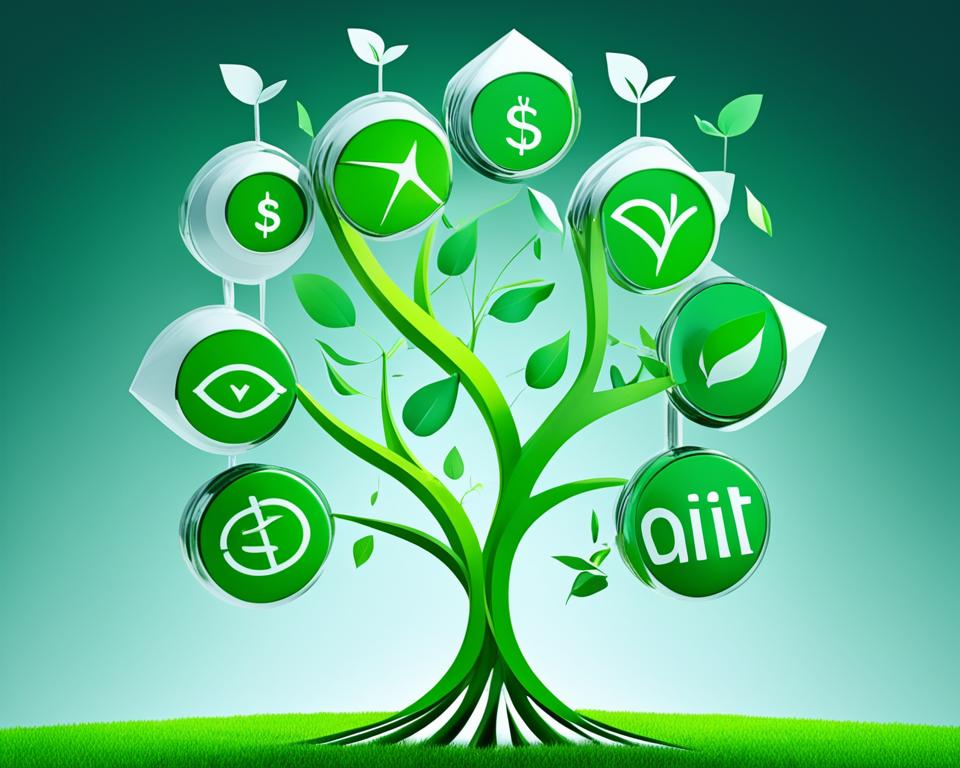
Assessing a company’s fiscal longevity involves delving into dividend payout and retention policies, where management prowess truly shines. For long-term growth and sustainability, companies need to plow back profits efficiently to fuel future ventures. However, they must also reward you, the investor, through dividends, ensuring your stake grows in tandem with the company’s prosperity. It’s this strategic balancing act that displays a company’s commitment to sustaining shareholder value over time.
What portion of the profits is being channeled back into the company? and How much is being doled out as dividends? are questions at the heart of the fiscal management conundrum. Dive into the financial statements of the company and focus on the narrative spun by their fiscal data—such as the Retained Earnings and Dividend Payments—to grasp the efficiency and direction of their fiscal endeavors.
- Review the company’s track record in fiscal decision-making.
- Consider how past decisions on capital retention versus dividends shaped current shareholder value.
- Analyze how such fiscal strategies are likely to impact future dividend distribution patterns.
Ultimately, by examining how well a company manages its finances with an eye towards prudent dividend distribution, you can ascertain how well positioned you are to partake in its financial gains, both today and in the years to come. Management’s competence in these fiscal matters is not just an indicator of the potential for consistent dividends but a cornerstone for solidifying ongoing and increased shareholder value.
Addressing the Retained Earnings and Future Investments
As you explore the financial terrain of potential investments, understanding the strategic role of retained earnings in a company’s long-term prosperity becomes pivotal. These reserves, a measure of the undistributed profits, serve as a critical indicator of a company’s sustainability and potential for growth opportunities. Let’s delve into how these earnings are a reflection of financial acumen and a predictor of lucrative dividends in times to come.
Correlation Between Retained Earnings and Growth Opportunities
Retained earnings are often viewed as the financial springboard from which companies can leap into new ventures or upgrade their operational capacities. Astute investors like you assess how these earnings are earmarked for capital expenditures or research and development, laying a foundation for innovation and market expansion. Here’s a breakdown of how these retained funds can manifest into tangible growth prospects:
- As a seed for technological advancements, boosting productivity and efficiency
- Through geographical expansion or acquisition, spurring market dominance
- By investing in workforce skill upgrades, harnessing human capital for competitive advantages
- In product development, fostering a pipeline of new and improved offerings
Risk Assessment of Dividend Continuity Relative to Capital Expenditures
The delicate balance between funding future growth and preserving dividend continuity is a complex dance that demands investor attention. Monitoring how much of the retained earnings are funneled into capital expenditures affords insights into the company’s strategic priorities. Are dividends being sustained at the cost of growth, or is the company effectively calibrating its investment strategies? Consider the following aspects:
| Financial Year | Retained Earnings | Capital Expenditures | Dividend Issued |
|---|---|---|---|
| 2021 | $200 Million | $120 Million | $80 Million |
| 2022 | $220 Million | $100 Million | $120 Million |
| 2023 (Projected) | $250 Million | $150 Million | $100 Million |
This table serves not just as historical data but as a catalyst for forward-thinking investment acumen. The trend of how retained earnings are allocated towards capital expenditures directly correlates to the flexibility and future profitability of a company—a key factor in the assurance of ongoing dividends. Sharp-eyed investors like you weigh these variables to gauge both present and future financial health, ensuring that today’s investment decisions seed tomorrow’s financial harvest.
Evaluating the Impact of Buybacks on Dividend Sustainability
When you hear about a company engaging in share buybacks, it’s essential to consider the action’s ramifications on the sustainability of dividends. Buybacks, influential in corporate financial strategy, often serve dual purposes: they can signal management’s confidence in the company’s undervalued shares and potentially enhance shareholder value. Yet, these buybacks also shift the financial landscape, which may affect the cash available for regular dividends, thus impacting dividend impact.
Why might a company choose to funnel funds into repurchasing its own shares? One reason stands out: to optimize shareholder value. By reducing the number of outstanding shares, buybacks can improve key financial ratios, such as earnings per share (EPS), which can make the remaining shares more appealing to investors. However, the impact on dividend sustainability is a nuanced puzzle, one that you need to piece together by looking at not only the present gains but also the strategic future implications.
Consider, for instance, the need to balance immediate shareholder rewards with the imperative of future growth. How does a company’s decision to buy back shares reconcile with its reputation as a consistent dividend payer? If buybacks lead to a boost in share prices but come at the cost of reduced cash reserves, future dividends might be compromised, requiring a delicate strategic alignment to ensure ongoing investor enticement.
A financial strategy makers must be careful not to conflate share buybacks with an inherent benefit to all shareholders. The buyback initiative might please the investors looking for short-term gains through elevated share prices, but those who depend on dividends for steady income could find their expectations unmet if the cash used for buybacks hampers the company’s ability to maintain its dividend distribution rates.
Your keen eye must also look for red flags. If a company is taking on debt to fund buybacks, ostensibly to prop up share prices, the long-term dividend impact could be negative. High-interest payments could eat into future profits that would otherwise be available for dividends. Thus, sustainability in dividends becomes ever more dependent on the company’s strategic agility and its ability to generate revenue that outpaces its debts.
Let’s take a closer look at how companies navigate this scenario:
| Company | Cash Spent on Buybacks | Long-Term Debt Incurred | Available Dividend Pool Post-Buybacks |
|---|---|---|---|
| Gigantic Tech | $2 Billion | $500 Million | $1.5 Billion |
| Retail Corp | $500 Million | None | $1 Billion |
| Global Finance | $1 Billion | $200 Million | $800 Million |
This table demonstrates varying strategies and their potential effects on dividend payouts. While a company like Retail Corp avoids new debt to fund buybacks, thereby maintaining a robust dividend pool, others may trade the short-term share price increase for a more constrained dividend budget.
As a discerning investor, you should view share buybacks through a multifaceted lens, measuring them against the enterprise’s overall financial strategy and considering how they balance dividend impact with investor expectations. Share buybacks can indeed be a sign of strong performance and confidence, but they should complement, not compromise, the tenets of dividend sustainability.
Sustainability of Dividend Payments: Investor Spotlight
In the intricacies of the stock market, seasoned investors often shine a spotlight on dividend sustainability, scrutinizing it as a measure of a company’s long-term viability. Understanding the past and present dividend practices allows these investors to navigate future uncertainties with greater confidence. Real-world examples offer a crystalline view of dividend strategies and their implications, rooted in historical performance and management decisions.
Case Studies of Dividend Sustainability
Investors frequently turn to case studies of companies like Apple, Johnson & Johnson, and Coca-Cola, which have historically displayed robust dividend distribution patterns. These narratives tell tales of strategic financial planning where dividends are not merely afterthoughts but pivotal considerations within corporate policies. For instance, consistent dividend increases despite economic downturns have affirmed companies like Microsoft in their commitment to shareholder returns, reinforcing their reputation for stability among investors.
One instructive case is AT&T’s revision of its dividend in response to shifting business strategies and market demands. The telecom giant’s needs to invest heavily in infrastructure and spectrum licenses have prompted a reallocation of capital, affecting their dividend distribution. Such cases underscore the importance of investor due diligence, where scrutiny of a company’s financial history, including free cash flow and debt service ratios, becomes vital.
Investor Sentiment and Reaction to Dividend Adjustments
Investor sentiment often sways in reaction to dividend announcements, where adjustments serve as a barometer of corporate health. ExxonMobil, for instance, has faced investor scrutiny as fluctuating oil prices and global demand impact its dividend payouts. When companies like this titan of industry sustain or enhance their dividends, it signals confidence to investors, positively influencing market sentiment. Conversely, unexpected reductions can spark concern, prompting shareholders to reassess their stake in a company’s future.
A keen example would be Wells Fargo & Company, which, in the wake of fiscal challenges, had to slash its quarterly dividend, resulting in a stir among investors centering on the bank’s earning potential and long-term strategic foothold within the sector.
The interplay between a company’s dividend decisions and investor sentiment can cascade into substantial market movements. These realizations guide investors like you to apply a discerning eye on dividend histories and the entities’ broader strategic orientations—a practice that not only gauges immediate returns but anticipates future financial currents.
| Company | Dividend History | Recent Adjustments | Investor Sentiment Post-Adjustment |
|---|---|---|---|
| Apple Inc. | Years of consecutive increases | Continued growth | Positive, owing to consistent performance |
| General Electric | Historically strong, now varied | Cuts due to restructuring | Mixed, with some concerns on future sustainability |
| ExxonMobil | Relatively stable | Steady amidst industry challenges | Cautiously optimistic, tied to oil market prospects |
As these case studies illuminate, understanding the narrative behind dividend sustainability is as much about assessing financial metrics as it is about tuning into the collective investor sentiment. Frequent adjustments to dividends, whether positive or negative, can catalyze a reactive pulse throughout the investment community, informing your strategic choices and portfolio allocations.
Conclusion
In the pursuit of wise investment, you’ve traversed the landscape of dividend analysis, armed with an arsenal of metrics and an acute awareness of market dynamics. It’s this vigilant approach, blending an understanding of financial reports with industry and economic forethought, that steers you towards sustainable returns. The key lies not just in the figures that flicker across the screen, but in the stories they tell of fiscal resilience and management mettle.
Cumulative dividends, payout ratios, and coverage metrics form a constellation of data points that guide your analysis. Sift through these grains, examining each company’s ability to navigate the unknown with a robust ledger and a prudent reinvestment strategy. Your aim as an investor? To distill the complex aroma of financial narratives into a rich brew of potential and prosperity. The journey through the galaxy of investment opportunities is luminous with the possibilities of both immediate returns and future growth.
Your map is periodically redrawed by the unseen hands of macroeconomic trends and corporate decision-making. However, with the compass of dividend analysis in hand, you bolster your portfolio against the winds of change. Engage in this methodical exploration to crystallize a spectrum of opportunities that promise a future of sustainable returns. The horizon gleams with the potential of dividends that commend themselves as the fruits of both shrewd strategy and resilience—your assurance in an unpredictable economic theater.
FAQ
How do investors assess the sustainability of dividend payments?
Investors assess the sustainability of dividend payments through a comprehensive dividend sustainability analysis which includes examining the company’s financial health, cash flow, debt levels, dividend history, and payout ratios. They also look into the company’s earnings growth, coverage ratios, and the broader economic conditions that could affect sustainable dividends.
What are the implications of dividend yield when making investment decisions?
Dividend yield can greatly influence investment decisions as it provides insight into a company’s annual dividend in relation to its current stock price, offering a gauge of potential return on investment and how the company compares within and across industries. Investors use dividend yield calculations as part of their stock valuation process and industry comparisons.
Why is understanding a company’s operating cash flow important for dividend analysis?
Understanding a company’s operating cash flow is important because it highlights the efficiency with which a company generates cash from its core business operations. This knowledge, combined with an investigation into free cash flow sufficiency, helps investors forecast the company’s potential in maintaining a reliable dividend stream.
How do debt levels impact the sustainability of dividend payments?
A company’s debt levels can significantly impact its ability to sustain its dividend payments. High debt can drain resources away from dividends towards debt servicing. Investors evaluate the debt to equity ratio and interest coverage to determine if the company’s debt levels might lead to future dividend reductions or suspensions.
What is the dividend payout ratio and how does it relate to financial flexibility in uncertain economic times?
The dividend payout ratio indicates the proportion of earnings a company pays out as dividends to its shareholders. A sustainable payout ratio ensures that a company has sufficient financial flexibility to cope with economic uncertainty, by not overextending its financial reserves, which could compromise its longevity and ability to continue paying dividends.
How can historical dividend growth data provide insights into a company’s financial performance?
Historical dividend growth data can shed light on a company’s past financial performance and its approach to increasing shareholder value through dividends. By analyzing how dividends have grown over time, investors can gauge a company’s financial strength and its commitment to consistent dividend payments.
Why must investors consider macroeconomic factors and industry cycles when evaluating dividend sustainability?
Macroeconomic factors and industry cycles can cause fluctuations in a company’s performance and affect its ability to pay dividends. Considering these factors is crucial because they can influence a company’s profitability and cash flow, both of which are vital for maintaining sustainable dividend payments.
What role does cash flow coverage play in assessing dividend viability?
The cash flow coverage ratio plays a critical role in assessing dividend viability as it measures the ability of a company’s operating cash flow to cover its dividend payments. A high cash flow coverage ratio indicates a comfortable margin for the company to maintain or increase its dividends, making it a vital metric in dividend analysis.
In what ways does fiscal management contribute to dividend distribution?
Fiscal management contributes to dividend distribution by effectively balancing the need to retain earnings for growth with the goal of distributing profits to shareholders. Astute fiscal management reflects on a company’s long-term strategy and ability to provide consistent dividends, thereby influencing shareholder value.
How do share buybacks affect the sustainability of dividends?
Share buybacks can influence the sustainability of dividends by reducing the number of shares outstanding, often leading to higher earnings per share (EPS). This can increase the company’s ability to sustain dividends. However, buybacks must be evaluated as part of a broader financial strategy to ensure they don’t compromise the financial health of the company and its ability to pay dividends in the future.
What insights do case studies of dividend sustainability provide to investors?
Case studies offer real-world examples of how companies manage their dividend policies over time, under varying market conditions. They provide practical insights into the effectiveness of a company’s financial strategies, the fiscal prudence of management, and how certain decisions have influenced dividend sustainability historically.
How does investor sentiment react to dividend adjustments and what impact does it have?
Investor sentiment can significantly react to dividend adjustments, whether they’re cuts, suspensions, or increases, as dividends are a direct reflection of a company’s financial health. Positive adjustments can boost investor confidence and stock prices, while negative changes can lead to a decline in stock value and investor trust.

